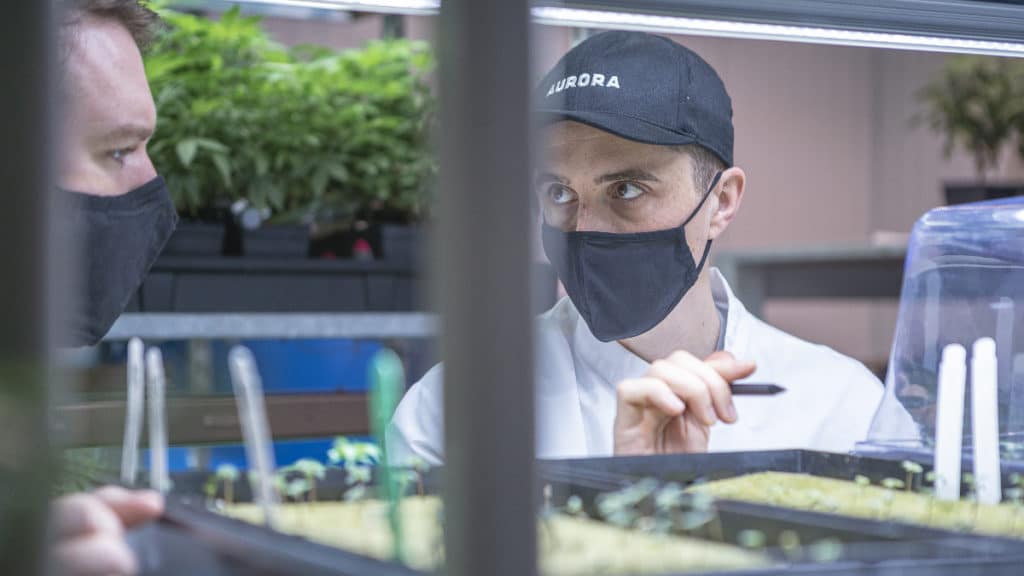Some of the seed sector’s most well-known names are popping up in the cannabis realm. Here’s why this crop represents new opportunities for these industry stalwarts. This story is Part 1 of 2.
Charles Pick began his career in forage seed in 1990. Serving as vice-president turf operations for the Pickseed Companies Group — a company co-founded by his grandfather and run by his father and uncle — his interests quickly grew into the biotech space. He worked for BASF for 11 years leading their genomics lab DNA LandMarks, eventually spurring him to found his own biotech consulting firm and then work in one of the country’s newest spaces — cannabis.
As senior vice-president science and innovation for Aurora Cannabis, he’s now helping lead one of the world’s top cannabis companies as it rapidly expands and prepares to mark three years since recreational cannabis was legalized in Canada.
“A friend of mine said, ‘You know, your knowledge would really be applicable to the cannabis industry.’ It appeals to the ag science background that I have, because to a certain extent cannabis has been totally untouched by modern agricultural practices. It’s almost like discovering a new species because so many improvements can be made,” says Pick.
The irony of him starting his career in forage and ending up in cannabis is not lost on Pick and his family.
“Cannabis is nothing I ever expected to work in. My dad likes to tell people that at least I’m still in the grass business.”
Don’t let the sense of humour fool you, though. Pick is serious about cannabis. Aurora is Canada’s top medical cannabis platform in terms of revenue. It’s also one of the leading international cannabis platforms. Headquartered in Edmonton, it has licensed production facilities across Canada and Europe, and serves patients and consumers worldwide.
With recreational cannabis increasingly becoming more socially acceptable in Canada and beyond (retired Canadian Olympic athlete Perdita Felicien recently called for the plant to be removed from the Games’ banned substances list, for example), Pick says the story of cannabis is only in its infancy.
Three years ago, when Canada was preparing to legalize recreational cannabis, questions abounded among market analysts in regard to access to germplasm and how the market would shape up as the cannabis economy began to evolve. Product shortages were the norm as cannabis stores began opening their doors in October of 2018.
Fast-forward to 2020 and Canadian cannabis sales doubled, according to Brightfield Group’s latest Canadian Cannabis Market report, which pegged sales at $2.6 billion last year. Furthermore, the Canadian adult-use cannabis market grew 118% in 2020, dominated by flower. You might say cannabis is coming into its own.

Breeding Breakthroughs
Aurora recently celebrated a portfolio refresh and launched three new cultivars.
“Our breeding and genetics program has been a huge success for us. These three cultivars are the first new genetics that stood out in a couple of years, as we’ve largely been running with the same portfolio products for the last three years,” Pick says.
“We also have cultivars that that are commercially ready that are being trialed by other companies as well, and we’re talking to those companies about licensing our genetics. That’s a big piece for us.”
Aurora’s cannabis innovation centre in Comox, B.C., is the epicentre of the breeding work that led to the three newly released cultivars.
Opened in 2019, the 32,200 square-foot facility is as big as some commercial production facilities.
“Building this breeding facility was a huge investment. Staffing it with scientists and breeders is not a small commitment. Every gram of cannabis that we produce here has to be destroyed. We have a research licence, meaning we can’t use it for anything else,” Pick says.
“We can’t use it for distillate or any other product. It’s dedicated solely to breeding and genetics. It represents a huge commitment to science and innovation on our part.”

All About the Quality
As research progresses, so does the industry’s knowledge of the science behind the cannabis plant.
“A big majority of our effort right now is focused on creating quality products. That’s about chemistry to a large extent,” says Greg Baute, senior director of breeding and genetics for Aurora.
A lot goes into making a quality cannabis product, Baute notes. Yes, THC plays an important role, but just as key are appearance, flavour and aroma. Aurora works with focus groups to determine what product qualities appeal most to consumers.
“Cannabis is a lot like wine. People consume it for the aroma, the bouquet. We spent a lot of time literally going out and smelling the flowers, looking for those unique profiles. Every now and then something pops up that just really blows us away.”
Like Pick, Baute also comes from a seed industry family. His dad founded corn seed company Maizex Seeds. After a stint with Monsanto as a trait geneticist, Baute moved to the cannabis space in order to work in a crop whose genetic secrets researchers are only beginning to unravel.
“I was working in California when it was legalized there. I ate lunch with plant breeders every day, and so many of us were talking about the research they wanted to do in cannabis. It’s decades behind every other crop. The research done in tomatoes and peppers in the 1950s, that’s the basic sort of stuff we’re doing right now in cannabis. That’s what made me think, ‘I should really think about cannabis as my next career.'”













